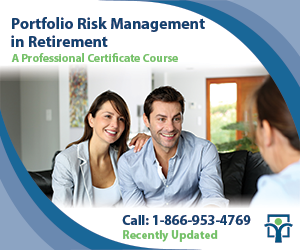Last updated: March 14 2017
Portfolio Risk Management in Retirement Course to Efficiently Manage and Increase Family’s Net Worth

Canadians who reach age 65 are more likely than ever to live into their 90's thanks to healthier lifestyles and a decline in heart disease. But this lengthens the retirement income planning period. Therefore, a renewed focus on continued capital accumulation and preservation is as important as the tax-efficient withdrawal of funds. Knowledge Bureau’s recently updated Portfolio Risk Management in Retirement course reviews the measurement and calculation of risk and return from this perspective.
Baby boomers have, in fact, amassed enormous wealth. They are also approaching retirement during a period of historically low interest rates. Many have felt the effects of major upheaval in the markets, to the extent that they’ll have to work longer, or re-set their expectations for the type of retirement they can afford.
This course gives will help students understand how the interaction between returns, risk, diversification and alpha-focused strategies will help you to make better judgements about investments solutions relating to the retiring client.
The student will be exposed to software and online tools that will aid in the application of the concepts discussed throughout the course. Discussions and examples of how to employ these tools will be featured throughout the course graphically and in case settings.
Also, of great value will be the orientation of portfolio creation and management in the context the current changing environment on decision-making for risk and return, and how it weighs on an aging demographic. In addition, you’ll learn more about the current interest rate environment and how it manifests into increasingly complex solutions that are required to develop risk mitigation strategies for both pre-retirees and retirees.
In this course, you will learn to:
- Revisit financial literacy relating to investment activities to measure risk and return.
- Explain and integrate Modern Portfolio Theory within decision-making with clients, relating it to a post-financial crisis environment that still bears a number of short and long term risk factors.
- Use financial literacy to guard against complaints around inappropriate risk tolerance or investments.
- Evaluate a variety of risks within asset classes using a multi-dimensional approach.
- Use the combination of both risk and return to make more informed recommendations.
- How these processes can help you simplify and make more money in your practice.
Using the power of simulations and modelling, as well as a defined process for goal setting and financial assessments, students will learn to explain the most powerful financial concepts to predict and evaluate risk and return in the retirement period, use current data to make investment decisions and then monitor changes in personal net worth as a result of sound decision-making:
 |
- How to measure different types of returns.
- How to measure, interpret and communicate standard deviation.
- How the principles of correlation and beta can be used to reduce risk.
- How the power of Modern Portfolio Theory and the Capital Asset Pricing Model assists in key asset allocation decisions.
- How the Capital Market Line can be used to enhance the risk / return relationship.
- How to use different software tools to apply this knowledge in your practice each day.
What our Students Say:
“I love how this course brought a richer understanding of market terms and theory. Then topping it off with the tools we need to continue what we have learned to enrich our profession and benefit our clients. A much-needed course for all financial advisors in today's market.” Barry A., NB
Knowledge Bureau’s Portfolio Risk Management in Retirement course is a component of the Retirement and Estate Services Specialist – Master Financial Advisor™ designation. For more information about the course, click here.





